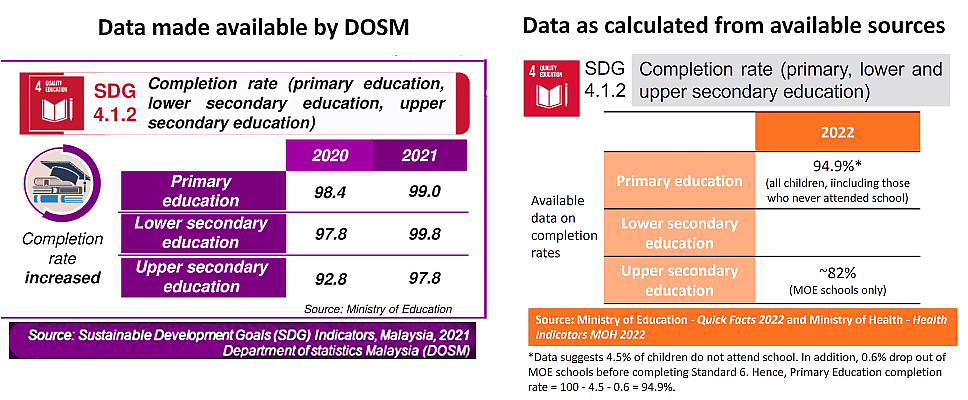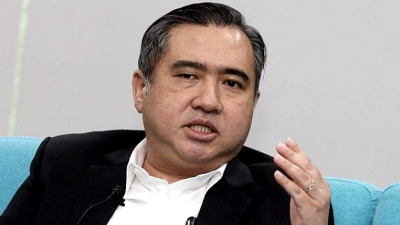
A key indicator towards meeting Sustainable Development Goal 4 (SDG 4) on quality education is that all children complete primary and secondary education, and that this is free and of high quality.
To monitor the country’s progress, the Department of Statistics Malaysia (DOSM) recently shared the purple graphic below showing impressive rates of completion, with an increase in 2021 despite the pandemic.
But, do they give a complete picture?

These DOSM statistics, sourced from Ministry of Education (MOE) data, suggest that Malaysia is doing very well with 99.0% of children completing primary education, 99.8% completing lower secondary education and 97.8% completing upper secondary education for the year 2021.
These numbers are surprising, given the anecdotal evidence that Malaysian children (as well as children from other jurisdictions) have experienced enormous learning loss in the pandemic years.
Intrigued, we took a closer look at the statistics.
In principle, to address any shortfall and improve our education system and provide quality access to education for all, it is first essential that the data we rely on are cross-checked, reviewed and accurate.
We started off by reflecting on what the situation is for indicator 4.1.2 based on MOE data available in MOE Quick Facts 2022 and Ministry of Health (MOH) data available in MOH Health Indicators 2022.
School attendance and dropout in MOE schools
Previous annual MOE Quick Facts documents show data for the same batch of students at two points of time within their schools.
At face value, they confirm the trend highlighted by DOSM. However, with further analysis, it is apparent that dropout rates during transition years and the rates of non-enrollment of children at the beginning of the school year have not been included, as can be seen by the following data.
Primary education
- Year 2017: 440,025 students enrolled in Standard 1;
- Year 2022: 437,414 students enrolled in Standard 6 (the same batch of students).
This means 2,611 students dropped out, giving a primary education completion rate of 99.4% for 2022 which shows the increase noted by DOSM in 2021.
Similarly, we can see good secondary education completion rates from the MOE Quick Facts.
Lower secondary
- Year 2020: 386,695 in Form 1;
- Year 2022: 387,160 in Form 3.
Upper secondary
- Year 2021: 373,943 in Form 4;
- Year 2022: 371,243 in Form 5.
We noted that the data do not take into consideration the “life course” of the student and students that dropped out between the years assessed (transition years).
We proceeded to calculate this from the raw data as shown below:
Year 2021: 446,428 students in Standard 6;
Year 2022: 406,504 students in Form 1 (with an additional 12,995 students in Remove Class).
With this simple calculation, we noted that even with these official figures, only 94.0% of children continued their studies from Standard 6 to Form 1 in 2022. In real numbers, these figures mean that 26,929 children dropped out of school in 2022.
Overall, out of an average enrollment at Standard 1 of 450,000 students, only an average of 370,000 reached Form 5, i.e., 82.2%.
An average of 80,000 children, or 18% of those who attended MOE schools, dropped out.
Just relying on selected figures provided by MOE, we realized that the way SDG indicator 4.1.2 has been reflected is misleading and that our achievement of this vital indicator is more limited than shown.
School attendance in non-MOE schools
Another crucial oversight is that the DOSM data for SDG 4 does not account for or take into consideration the many children who do not attend MOE schools.
Using the Health Indicators MOH 2022 data on live births for the year 2016, i.e. children expected to enter Standard 1 in 2022, it is apparent that there were 508,203 live births in 2016.
Year 2022 MOE enrollment data for Standard 1 show 454,530 students. Hence, there is a shortfall of 10.6% of children (53,673) who are not enrolled in MOE schools (government or government-aided schools).
It may be assumed that most of these 53,673 children are enrolled in religious schools (tahfiz), private schools, international schools, home schools, etc.
MOE Quick Facts 2022, Tables 3.3 on Enrollment at Primary Level in Private Institutions (2022) and 3.4 on Enrollment at Primary Level in Institutions under Other Government Agencies (2022) offer some indication of the total number of children in these institutions.
Religious schools (tahfiz), private schools, international schools, home schools, etc.
- Year 2022: 26,030 is the approximate total number attending Standard 1 in these institutions based on an average of six class years of attendance.
At this juncture, a question rises to the fore: given that these are not MOE institutions, how are the quality of education and dropout rates of children enrolled in non-MOE institutions monitored?
Children who do not attend school
The data (in MOE Quick Facts 2022, read together with Health Indicators MOH 2022 data on live births for the year 2016) as scrutinized above, underscore the fact that in 2022, the schooling options for 27,643 children are not accounted for:
508,203 live births in 2016 minus 454,530 students enrolled in Year 1 in 2022 minus 26,030 students enrolled in non-MOE institutions = 27,643 children.
MOH data would suggest that about 4,000 to 5,000 of these children would have died before the age of 7 years.
One question requires an answer: where are the remaining children who ought to be in school getting educated? Are these stateless children, children in detention, children of migrants and refugees, or children with disabilities?
It appears that there are some 20,000-plus children the system has not accounted for each year and who are not captured in Malaysian SDG 4 data.
The bottomline (summary)
The true shortfall in our education system is staggering–children not attending any school (4.5%) or dropping out of school before reaching Form 5 (18%).
The above review, based purely on data made available by MOE and MOH, indicates a crisis in our education system: it is far from being inclusive and equitable.
The data call for an urgent review of the quality of Malaysia’s education system and its accessibility so that no child is left behind.
We recently highlighted our children’s enormous learning loss due to the pandemic learning loss, the highest among Asian developing nations and exceeding that of all ASEAN members, except Myanmar.
We believe that this learning loss, which is still to be officially acknowledged by MOE or addressed adequately, coupled with the limited enrollment and significant dropout rates, has huge economic and social implications for the nation and its economy.
We cannot afford continued inaction that will yield a less skilled labor force and higher mental health burden.
Malaysia needs more robust data that enable the identification and channeling of resources to support children who are not receiving formal education and those who drop out.
Given the above, we strongly recommend the following urgent measures for government action:
1. Revise Malaysian data on SDG 4 (indicator 4.1.2) to reflect the reality on the ground. We can only overcome the crisis if we acknowledge that a crisis exists, accept the situation and work towards finding solutions and implementing urgent remedial measures.
2. Strengthen comprehensive coverage and enable independent monitoring by the system for collecting and annually publishing data on:
-
- The quality of education and attendance at all primary and secondary education facilities;
- Attendance and enrollment, disaggregated by parameters, such as region/rural-urban location, ethnicity, disability, age, gender, and other parameters such as undocumented, refugee/migrant status;):
- ALL children in Malaysia;
- ALL school environments in Malaysia.
3. Identify and reach out to school dropouts to enable their return to schooling or fast-track them to vocational skills training and employment.
4. Identify vulnerable children and schools that require more support, including financial aid, to enable those from poor families to return to school and complete schooling.
5. Enforce the implementation of a genuine no-reject-policy that allows all children, regardless of status, documented or undocumented, to attend school and complete schooling.
This is a basic right enshrined in three Conventions that Malaysia has ratified: the Convention on the Rights of the Child, the Convention on the Elimination of All Forms of Discrimination against Women, and the Convention on the Rights of Persons with Disabilities, as well as in the Sustainable Development Goals that Malaysia has committed to fulfilling.
Any loss of education in a child’s life is a loss for the child and for the nation.
If we leave any child behind, we are undermining our nation’s prospects.
Just as “it takes a village to raise a child,” similarly it takes every child to make the village and the nation.
We neglect our children’s education at our own peril.
(Dato’ Dr Amar-Singh HSS, Consultant Paediatrician and Advisor, National Early Childhood Intervention Council (NECIC); Yuenwah San, Honorary Senior Advisor (Disability Inclusion), Social Development Division, United Nations Economic and Social Commission for Asia and the Pacific (ESCAP); Gill Raja, Retired Lecturer in Social Policy and Social Work, Committee Member, Sarawak Women for Women Society; Srividhya Ganapathy, Co-Chairperson, CRIB Foundation; Ng Lai-Thin, Educator in Special and Inclusive Education and Project Officer for NECIC; Dr. Ong Puay-Hoon, PhD (Cognitive Science), Dyslexia Association of Sarawak.)
ADVERTISEMENT
ADVERTISEMENT








































